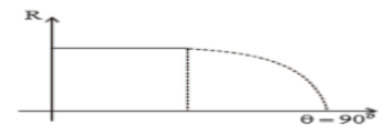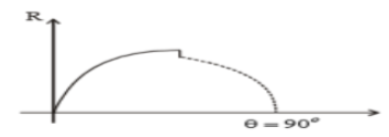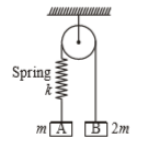A block is kept on a rough inclined plane with angle of inclination . The graph of net reaction (R) versus is:
1.

2.

3.

4.
None of these
1.  2.
2. 
3.  4. None of these
4. None of these



1.
 2.
2. 
 4. None of these
4. None of theseA block is placed on a rough horizontal plane. A time dependent horizontal force F=kt acts on the block. The acceleration time graph of the block is :
| 1. |  |
2. |  |
| 3. |  |
4. |  |
1.  2.
2. 
3.  4.
4. 
A motorcycle is going on an overbridge of radius R. The driver maintains a constant speed. As the motorcycle is ascending on the overbridge, the normal force on it:
1. Increases
2. decreases
3. remains the same
4. fluctuates erratically
A rod of length L and mass m is acted on by two unequal forces and as shown in the following figure


The tension in the rod at a distance y from the end A is given by :
1.
2.
3.
4. None of the above
Two blocks A and B of masses m & 2m respectively are held at rest such that the spring is in natural length. Find the accelerations of both the blocks just after release.


1. \(g \downarrow , g \downarrow\)
2. \(\frac{g}{3} \downarrow , \frac{g}{3} \uparrow\)
3. (0, 0)
4. \(g \downarrow , 0\)
Two blocks 'A' and 'B' each of mass 'm' are placed on a smooth horizontal surface. Two horizontal force F and 2F are applied on both the blocks 'A' and 'B' respectively as shown in figure. The block A does not slide on block B. Then the normal reaction acting between the two blocks is:


1. \(\text F\)
2. \(\text F /2\)
3. \(F \over \sqrt 3\)
4. \(3F\)
Five persons A, B, C, D & E are pulling a cart of mass 100 kg on a smooth surface and the cart is moving with acceleration 3 in east direction. When person 'A' stops pulling, it moves with acceleration 1 in the west direction. When person 'B' stops pulling, it moves with acceleration 24 in the north direction. The magnitude of the acceleration of the cart when only A & B pull the cart keeping their directions same as the old directions are:
1. 26
2.
3. 25
4. 30
A body moves along an uneven surface with constant speed at all points. The normal reaction due to ground on the body is:

| 1. | maximum at \(A\) |
| 2. | maximum at \(B\) |
| 3. | minimum at \(C\) |
| 4. | the same at \(A, B\) and \(C\) |
Two masses, \(m\) and \(M\), are connected by a light string passing over a smooth pulley. When mass \(m\) moves up by \(1.4\) m in \(2\) sec, the ratio \(\frac{m}{M}\) is:
| 1. | \(\frac{13}{15} \) | 2. | \(\frac{15}{13} \) |
| 3. | \(\frac{9}{7} \) | 4. | \(\frac{7}{9}\) |
A car is moving in a circular horizontal track of radius 10 m with a constant speed of 10 m/sec. A plumb bob is suspended from the roof of the car by a light rigid rod of length 1.00 m. The angle made by the rod with the track is
1. Zero
2. 30
3. 45
4. 60


